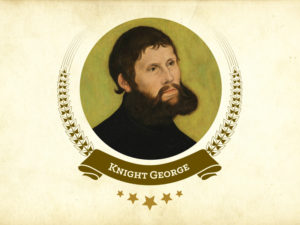Celebrating the 500th Anniversary of the Reformation
Faces of the Reformation: Knight George

Knight George
Our latest Faces of the Reformation article will introduce you to the most famous person of the Reformation, Knight George. You are probably asking a couple of questions: Who is Knight George? and How could he be the most famous person of the Reformation? Read on and find out!
In 1521, the Holy Roman Emperor, Charles V, called Martin Luther to a special meeting in the German city of Worms. Luther thought he was called to the meeting to debate his questions for the Catholic church, but really, he was summoned to Worms to recant his writings. It was at this meeting that Luther gave his firm and courageous answer to the powers of the church by saying: “Unless I am convinced by Scripture and plain reason, I do not accept the authority of popes and councils, for they have contradicted each other. My conscience is captive to the Word of God. I cannot and I will not recant anything, for to go against conscience is neither right nor safe. Here I stand; I can do no other. God help me. Amen.”
Outlaw
Needless to say, Charles V was not happy with this answer and he quickly called Luther an outlaw of the church and threatened him with being called a heretic. Charles granted Luther safe passage back to his home in Wittenberg, but this safety was only to last 21 days. On the way home, several armed horsemen stopped Luther’s wagon, pulled him off the wagon and took him away. Luther’s friends thought they would never see him alive again, but this was simply a plan arranged by Luther’s protector, Frederick the Wise, to protect Luther and keep him safe.
Luther was taken to Wartburg Castle. There, he grew his hair longer and grew a beard to disguise his appearance. He dressed as a knight would and took the name “Knight George.” While Luther was indeed safe, at the Wartburg castle, he was also bored and lonely. Finally, he went to work and during the 10 months he lived in exile at Wartburg Castle, he completed a German language translation of the New Testament. At last, the Holy Bible could be placed directly into the hands of the people! Luther also wrote a commentary of Psalm 68 and on the Magnificat, Mary’s response to the news that she was to be the mother of Jesus, the Messiah.
Painful Following
Unfortunately, while Luther was safely hidden away from the officials of the church who were trying to find him, other people associated with the Reformation were active in very negative ways. They felt it was their duty to destroy all things from the Catholic church and churches were burned, altars were destroyed, images of saints were damaged. Hearing these disturbing activities, Luther ended his time as “Knight George” and returned to Wittenberg. He quickly restored peace to his followers, preaching a series of sermons that brought calming and healing to the people.
Luther’s exile was over, but for the rest of his life, the Edict of Worms that declared Luther a heretic hung over his head. Through the guidance and protection God provided him through Frederick the Wise, Luther remained safe in Germany to continue his work as the father of the Reformation.
From Trinity Lutheran Church Faribault, May, 2017 Newsletter
RELATED POSTS

New Audio and Video Podcasts
Audio and Video Podcasts are Here! We know that sometimes it is not easy toRead More

LCMS Ministry to the Armed Forces
From the LCMS Ministry to the Armed Forces. We invite all of you to readRead More